|
|
|
Mauritius - Day Tour in the West of the Island
Our tour in the west part of Mauritius begins with a big step back to the colonial preriod. We visit two colonial houses and get a picture of how life was more than 200 years ago in Mauritius. From the colonial house Eureka we make a little side trip to the belonging park, where we make for the first time a short hiking tour through the tropical rain forest. Then we make a massive time step into the past by visiting the long ago extinct volcano in Curepipe. Then, we simply enjoy our tour through the highlands of the island and drive alongside the west coast in direction to the north, where we gaze at the Matterhorn of Mauritius and maybe do a side trip into a bird park. 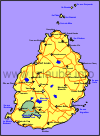
Our tour is of a length of approximately 100 km and we also drive through the Black River Gorges National Park; but we only drive through this great area, as the sightseeings that are described here are very time-consuming. A drive through the National Park is an extra tour, see the page of the Tour through the South. Those who live in the north-west of the island have indeed only a few kilometres way up to the first station, the Domaine Les Pailles, right behind Port Louis, but as the morning rush hour has to be considered in the time schedule, the drive stil takes an hour; the same of course applies for the trip back in the evening.
Domaine les PaillesAt only a quarter of hour distance from Port Louis there is, underneath the mountain Le Pouce, the Domaine les Pailles. Here, people do an excursion back to the good old times of the island in the 18th century and view some old colonial villas, sugar cane fields, herb gardens, rum distilleries, ect. right the way life was in the colonial times in Mauritius. But it is to be said in advance that this paradise did not survive all these centuries without any damage; The whole complax was rather completely rebuilt in the 80ies. Thus, in the Domaine les Pailles one does not visit any historical houses and complexes but one rather accesses an artificially created museum that provides one with the perfect ilusion of having an excursion back to the 18th century. 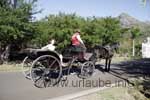
The time travel begins in the reception building that represents an old Creole house. Here, there is some general information available about the manor, there is a small souvernir shop and also, the tickets for the different attractions are sold. The Domaine les Pailles comprises a huge Areal that can be explored by different ways. All the most important attractions are located close to the entrance area, thus it can be comfortably accessed within walking distance. The only question is if a foot march in this "historical" complex is ethical. 250 years ago, the colonial masters went with the horse-drawn carriages or with the rail through their complex; And this is the way it should be today! The round trip with the horse-drawn carriage costs approximately 10 € per person; the expert guidance is included in that. We had a very friendly guide who did anything to make our tour as pleasant as possible. We could repeatedely stop in order to make some pictures, and we repeatedely got some useful comments concerning the buildings which we were currently looking at. While our carriage-ride took a good quarter of hour, with the rail it was clearly faster. Either the horse-drawn carriage as also the rail only drive their round through the inner area of the manor. In order to explore the whole area, one has to do it as it was done in former times on a horse; the manor has its own riding stable; the riding instructors take one with them to the guided tours. There are also exploring tours with the per all-terrain vehicle; this has indeed nothing to do anymore with the old colonial times. 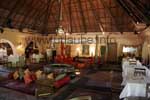
What is to see in the manor of the Domaine les Pailles? No matter if on foot or by horse, one repeatedely sees the sugar cane fields. Here, the sugar cane is cultivated in the old style and harvested on a daily basis. As a means of transport to the sugar mill, the little more modern trackers are not used but the oxen and horses. The sugar cane mill is an imitation true to original as it was used in former times: the oxen drive the press wheels, that literally take the very last drop of juice form the sugar canes that were previously inserted by hand. The following disstillation finally leads to the famous Rum, that is not necessarily adequate for drinking due to its high percentage (50-60%). Thus, as a visitor, one can closely observe how some hundreds years ago sugar and/or rum was produced from sugar cane. 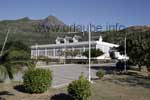
The visitor of course wants also see some gorgeous colonial houses and there are already two of those gorgeous villas: in one, a casino is arranged but it is not opened until the evening, in the other one, a Creole first-class restaurant is accommodated; No matter if one lets pamper his palate here or not, it is interesting to gaze at such huge villas with their surrounding and wide patio. One can then really imagine what a richness the sugar cane cultivation provided the former upper class. Those who get hungry in the Domaine les Pailles do not need to worry. Four restaurants invite the visitor to eat, one Italian, one Chinese, one Indian and, as already mentioned above, one Creole restaurant. We enjoyed the unique flair of the Indian restaurant; in an oriental, well-kept and clean atmosphere we had some delicious food and experienced a first class service. I can recommend everybody to have a look into this Indian gourmet mecca, also if one is not hungry. Only the stylish ambiente is a short visit worth. Those who want to visit afterwards the modern congress hall that is located at the bottom of the mountains will notice soon that time went by in a blink. We had planed a short visit to the Domaine les Pailles but including our delicious lunch we made a half day excursion of it. As a conclusion I can only resume that according to my opinion a visit of the Domaine les Pailles is a must of the island viewing. Due to the good possibilities to eat here I recommend to do this in the forenoon and finalise it with a good lunch meal in one of the four restaurants. Eureka Colonial HouseBy driving from Port Louis some kilometres on the motorway in southern direction, we get to an exit from which there are only a few minutes to one of the most gorgeous colonial houses of the island. Contrary to the Domaine les Pailles, Eureka is a genuine colonial villa that was already built in the year 1836. We parked our car and/or our taxi at a shady parking place; Right beside there was a small entrance house where we bought our tickets for the viewing. What we did not know until then was that at this place, we could not only admire the gorgeous colonial villa but also a little natural spectacle, but mor eon that in a minute. 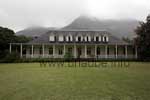
For approximately 10 € per person we got a private guidance through the old building of a surface of approximately 1000 m²; We make a round from room to room that are all arranged with furniture of the 19th century. It is fascinating to look at the old furniture made from high quality woods. But we were much more impressed by the rooms and the building themselves. Finally, the biggest room which was the dining room had a bigger surface than a standard flat in germany. We were also impressed by the room height of approximately 4 m. All the rooms are communicated to each other by some big double wing door, so that even in times of hot weather, there is always a little breeze blowing through the rooms providing some bearable conditions. 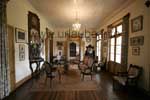
From each room there is a straight access to the veranda that is surrounding the complete house. These days, people can only dream of such a terrace. In the upper floor of the building, some sellers try to sell us some carpets, silk products and other items, but we soon left this area, as we still had to visit the kitchen that was located in a separate building outside the house. And finally, there was also the gorgeous garden, or is it better to say park? 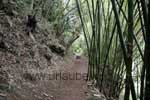
We have a little walk around the big outer plant and feel like the wealthy upper class of the 19th century. At the front part of the garden we look down to the valley of the river Rivière Moka; At the other side of the valley we look at a dense rain forest in which the vegetation sprouts out. And now an absolute and completely surprising highlight is to come: a narrow path leads into the valley through the tropical rain forest up to the river with its waterfalls. I say surprisingly because there was no tour guide and also no brochure that we got in the island that informed us about this extra tour. The lady who was our tour guide told us that this tour is only since a short time available and that this was not broadcasted yet in some travel guide books. 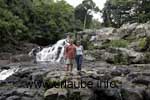
Thus we hike on a wide trail from the colonial villa through the tropical rain forest down to the river valley. After approximattely a quarter of an hour we arrive at the bottom. As we were only wearing sandals and due to the humidity it was a little slippery, we had to walk very slowly in order not to glide off. Once arrived at the bottom, a guide lady was again waiting for us who accompanied us on the long way through the rain forest and gave us a lot of interesting comments. For me, it was the first time that I walked through the tropical rain forest. It was absolutely fascinating to look at the bright vegetation. The were wild plants all over that were competing to get the best places at the sun. I learned that it is very humid in a tropical rain forest, as although it was not hot I was completely wet nd after half an hour soaked with sweat. Our very friendly guide lady took us to some wide trails, numerous stairs and small wood bridges up to the two Ravine-waterfall. For us it was simply totally fascinating to march through the tropical rain forest on the narrow paths. We had to stop repeatedely in order to look at the partly huge trees and plants. The tour ended in a small restaurant, where we arrived wet and sweaty and were glad to have a break. For us, the visit to the Eureka colonial house became a double highlight; Either the gorgeous colonial villa as also the tour into the tropical rain forest were some unique and unforgettable experiences that we like to remind. In total, one should plan 1,5 hours for this tour. Indeed, the area is soon migrated, but those who have never seen it before will repeatedely stop in order to make some pictures or simply to enjoy the views. What I still would like to mention is that the colonial villa is located at the bottom of the mountain. Here, there are frequently clowds and the water is released in form of a fine drizzle; thus, a rainy day is rather a rule than the exception. Curepipe and the Crater Trou aux CerfsBy driving the motorway furth er into the southern direction, we pass some highly located cities as Rose Hill and Phoenix (there where the island beer is brewed). All these cities do not interest us at all, we do not have a stop until we arrive at Curepipe. Curepipe is the second biggest city of the island; Port Louis is indeed the capital of the island, but many local people consider Curepipe to be the secret capital of Mauritius. In Curepipe there are numerous authorities and even the state president has here his president villa up there in Curepipe. I say up there due to the reason that Curepipe is located at a height of more than 500 m. While in the hot summer months it is hot and muggy in Port Louis, up here it is still pleasant and a fresh breeze blows. But Curepipe is also the coolest area of Mauritius with the most rainfalls. Due to its surrounding mountains and the height, many clowds let their water down over Curepipe. I have been several times in Curepipe and any time it rained, sometimes only in phases, sometimes really strong. Thus, one should always take an umbrella and a coat to the vist to Curepipe. But the frequent rain in Curepipe also has a big advantage: by driving the car alongside the city and also inside the city, one notices that some bright plants, bushes and trees grow. Here, the nature unfolds as it does in the rain forest. The streets have to be cut free regurlarly, as the bamboo hedges and other bushes would otherwise wildly expand. 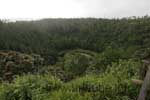
Since ever, the upper class of the island lived in Curepipe. During the colonial period some rich townspeople had there second residence up here for the case it became too hot for them in the lower regions. Still today, the rich inhabitants of the island live in the city district Floréal of Curepipe. In the city there are expensive shops selling jewelry and clothes, the kind of shops we also know in Germany. Here, one can, as a European, do normal shopping. But there are also diamond factories in Curepipe and ship model factories that can be visited. But if it is possible to shop here at reasonable prices is a thing I cannot say. For those who really want to do some shopping, a small city tour through Curepipe is really worthwhile. A visit to the botanical garden is not really wothwhile, as there is a much bigger one in Pamplemousse. But what should be visited in any case is the Trou aux Cerfs. The best is to drive with the car the road up for approximately 650 m, where one is located at the edge of a former volcano. From there above, one can nearly look into the nearly 100 m deep caldron, where there is a nice biotope from which a crater lake and a peripteral rain forest were formed. One can circumnavigate the crater either by car or by walking. Those who are very lucky will enjoy the view into the volcano crater under the radiating sun, but it is more probable that it dizzles or even rains. In good weather one of course has a glamorous view down into the valleys, and in case of very good weather one has even a view over to the neighboured island Reunion. But therefore one needs to be very lucky, as, as said before, Curepipe is the most rainy city of the island, and this of course also applies to the surrounding nature. Fresh Water Reservoir Mare aux VacoasIf we drive from Curepipe further to southern direction, we continuously stay in the highlands at a height of more than 500 m Curepipe is the last city of our route, after that, it gets rural and natural again. We enjoy the trip through the adjoining rain forest area Perrier Natura Reserve. At the left and at the right of the road it sprouds in all possible shades of green, the plants, bushes and trees use each square metre of surface to expand. Of course, they do get enough water from above. 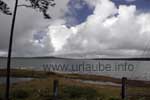
In these highlands there are also some fresh water reservois of the island located, we rightly pass the Mare aux Vacoas. We are impressed by the size of this lake: this little sea expands approximately 2 km to all directions. As we can feel the southeast trade wind here above, there are waves as in the sea and for a short moment we really think we are back down at the sea. But it is not so, from such reservoirs, the potable water is conducted to the island cities. While the tourists in Mauritius drink only bottleled water from the supermarket, for the local island inhabitants, drinking the normal potable water is a normal thing. But if the are some strong storms or cyclones over the island, the water of the fresh water reservoirs is strongly contaminated and also animal cadavers get into these lakes, so that the island inhabitants, during these times of storm and also some weeks after that, do boil their potable water and/or also make use of the bottleled water of the supermarket. TamarinAt the other side of the road and only accessible by walking, we found two other reservoirs, the Mare Longue and the Tamarind Falls. These reservoirs do not only serve as water providers but also as electricity providers in form of an hydroelectric power plant of the island. From the Tamarind-reservoir, the river Rivière Tamarin flows, that not far from the reservoir falls into a multi-stage waterfall for more than 200 m into the depth. This river flows then in western direction and disembogues into the sea at the place Tamarin. 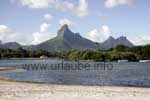
Tamarin is the next station of our round trip in the west of Mauritius. But we cannot take the straight way alongside the river, as some high mountains separate us from the coastal place. We either have to drive further to the south and cross the Black River Gorges National Park or we drive back to Curepipe and drive from there down to the west coast. As the first variant with all the related viewings is very time consuming, I described it in an extra-tour; thus, the faster variant is the return trip to Curepipe. Why do we drive to Tamarin? Actually, Tamarin is a tiny and insignificant place in the island. But we do find here a spot that we can really enjoy. We drive to a small beach section where the Rivière du Rempart flows into the sea. In order to have a sunbath at this gorgeous beach we have to wade through a piece of the river, a thing that is not a problem for us. At this beautiful beach, we find a pleasant relaxation from our until then very long tour. But I still did not mention a highlight. While we were viewing the mountains we saw something that we did not know yet from anywhere. It is the 545 m heighted mountain Mont du Rempart. We see the Matterhorn in Mauritius! Simply compare the picture of this mountain with the one of my Matterhorn-page. Simply unbelievable, isn't it? Casela Bird ParkFrom Tamarin, we drive barely 10 km to the nord and then, we are attracted by a big sign into the Casela Bird Park. It is a small private zoo that is specialised on tropical birds of Mauritius and other countries. This is surely a highlight for ornithologists; but for those whose time is slowly getting short can confidently leave this attraction behind, as there are many beautiful birds to see in very normal german zoos. For children, rather some footloose monkeys are more interesting than coloured birds that make some exotic noises. But in one point, the Casela Bird Park is well worth seeing in any case: if the weather is fine, one has from there above a fantastic view down to the west coast of the island; also the view to the park itself and to the adjoining sugar cane fields is impressive. Those who have still some time left should simply take a seat in the restaurant and enjoy the views and maybe also the sunset. 
Copyright: Patrick Wagner, www.tourist-guide.biz |
||
 During the visit of the colonial house Eureka, we make an excursion of 0,5 - 1 hour to the tropical rain forest. Here, it is very humid, so that I came out there nearly soaking, even if the exterior temperatures were not extremely high. Then, a small towel or the bath towel, that we anyway carried with us, was a good help in order to get dry again. Moreover, there are of course numerous mosquitos in the rain forest that love to bite. Even if it was wet and hot, one enjoys the tour more wearing long clothes, as they can be taken off, while otherwise, one has to enjoy the mosquito bites for a whole week...
During the visit of the colonial house Eureka, we make an excursion of 0,5 - 1 hour to the tropical rain forest. Here, it is very humid, so that I came out there nearly soaking, even if the exterior temperatures were not extremely high. Then, a small towel or the bath towel, that we anyway carried with us, was a good help in order to get dry again. Moreover, there are of course numerous mosquitos in the rain forest that love to bite. Even if it was wet and hot, one enjoys the tour more wearing long clothes, as they can be taken off, while otherwise, one has to enjoy the mosquito bites for a whole week...